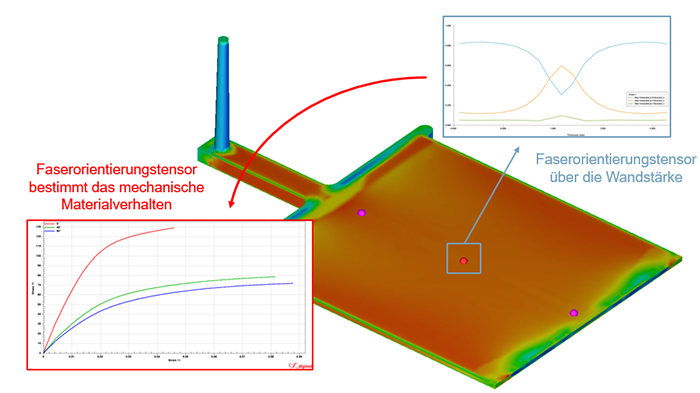
Optimization of process-dependent microstructure in injection molding by reverse engineering
SPEZIELL FÜR UNSERE ANWENDER
The process-dependent microstructure of a component is influenced on the one hand by the filler and on the other hand by the process control and other effects. The local fiber orientation as well as the fiber orientation across the wall thickness have a significant influence on the mechanical component behavior as well as the deformation behavior (warpage).
According to the state of the art, the fiber orientation can be simulated by numerical software tools (Moldex3D) on the one hand and measured by computed tomography on the other hand. Due to the cost, the CT scan is used in validations and verifications, whereas the low-cost simulation is opposed in the development of component designs.
Die heutigen Softwaretools bieten alle die Möglichkeit der Vorhersage von Faserorientierung im Bauteil. Hierbei stehen dem Anwender unterschiedliche Faserorientierungsmodelle zur Verfügung. Oftmals beruht die Auswahl bei einem kurzglasfaserverstärkten Thermoplast auf dem Foglar-Tucker Modell, welches die Faser-Faser Interaktion berücksichtigt, jedoch weitere Effekte wie Faser-Matrix oder die Retarding Prinicipal Rate vernachlässigt. Dahingegen steht im Moldex3D ein eigenentwickeltes Fasermodell -dem sogenannten iARD-Modell- zur Verfügung. Dieses Modell basiert auf physikalischen Materialverhalten und ist geometrie- sowie prozessunabhängig, womit die Materialkarte für die darauffolgenden Simulationen stets gültig ist. Mittels der Default Parameter liefert das iARD-Modell in Zusammenhang mit der leistungsstarken BLM Vernetzung genauere Vorhersagen der Faserorientierung, wodurch exaktere mechanische Eigenschaften für das Warpage Verhalten als auch eine höhere Datenqualität für die gekoppelte FE-Analyse erfolgt.
In order to obtain a further approximation to reality and the real component behavior, the fiber model can be calibrated based on experimental data. The fiber model is adapted to the real material behavior by means of reverse engineering and is then valid for the material map. The prerequisite is that the real material behavior is known from experimental investigations.
If you need support in the field of reverse engineering, we are happy to provide you with consulting and services ranging from the production of test specimens to a calibrated iARD model.
Please contact us: 0241 565 276-0 or send an email to info@simpatec.com .
